As anyone who visited or lived in Taipei back in the early 1990s or before will know, the metropolis (and its surrounding satellites) have undergone an amazing, almost unrecognizable transformation over the last 20 years. However, no part has changed more startlingly than New Taipei City’s Sijhih District (汐止), on the Keelung River about halfway between Taipei City and Keelung.
In the past, this low-lying area (the name means “limit of the tide,” since it lies at the upper limit of the tidal Keelung River) was once prone to suffering flood damage, a dubious reputation that came to a dramatic head with astounding TV footage of local houses under as much as one story of floodwater, following the deluge dumped on northern Taiwan by Typhoon Nari in 2001.
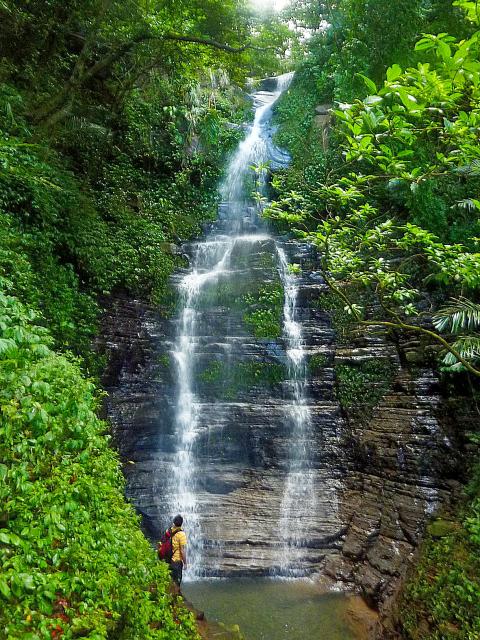
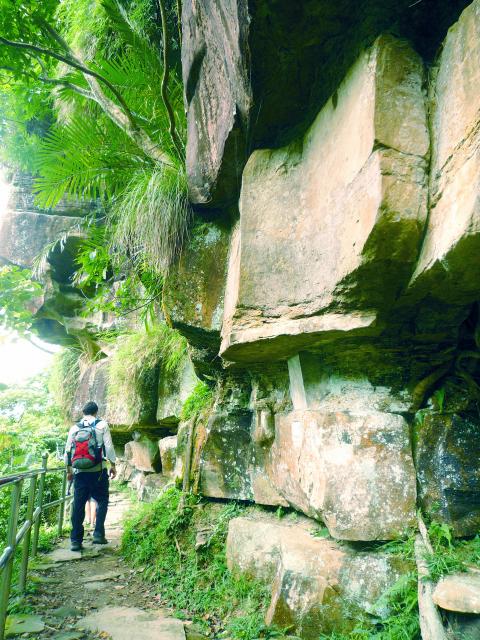
Photo: Richard Saunders
Following the disaster, a levee built along the river in 2002, and the completion of Yuanshanzi Flood Diversion Tunnel (圓山子分洪道) in 2005, finally rid the area of its curse, and these days Sijhih has undergone a major facelift, with modern high-rise office and apartment blocks much to the fore. The dramatic improvement in the district’s fortunes in recent years might not be a compelling reason to pay it a visit by itself, but its environs are rich in beautiful scenery, including one of New Taipei City’s most enchanting natural lakes, a smattering of shapely summits, three sets of waterfalls and several extraordinary curiosities.
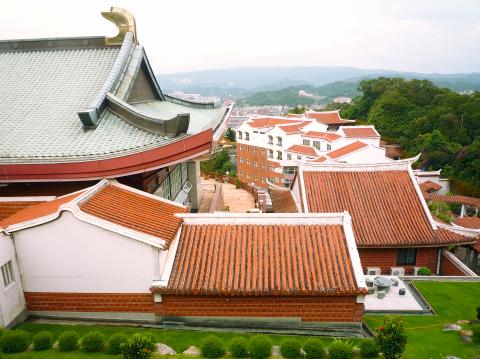
Most hikers take the train to Sijhih to climb the deceptively easy-looking eminence known — for reasons not at first apparent — as Dajian Mountain (大尖山), and it’s a very worthwhile hike. If you cheat and take the minibus part of the way up, the hike can be completed in a couple of hours, but the trip can be lengthened into a full day by heading southeast across the hills to New Taipei City’s Pingsi District (平溪) along a network of undeveloped dirt trails (bring a map).
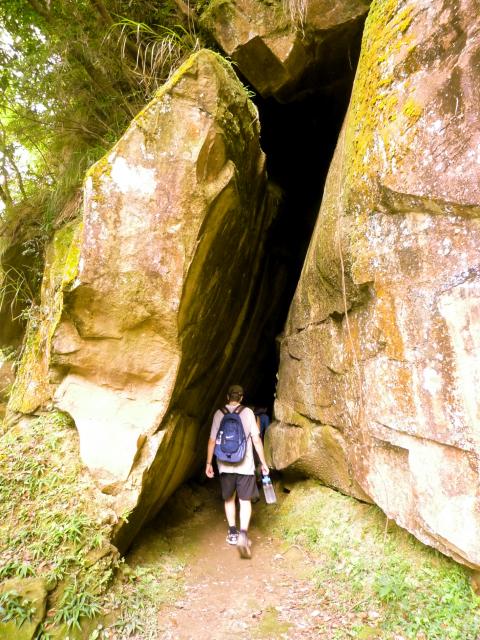
For a much shorter hike, walk (or take a minibus) up to Tiansiou Temple (天秀宮), passing close to the extraordinary temple of Zihhang Tang (慈航堂), and climb to the summit of Dajian Mountain via the beautiful Sioufong Waterfall (秀峰瀑布).
If you start the hike at Sijhih train station, walk south (away from the river) to the main road through the district (highway 5), turn right and then left onto Sioufong Road (秀峰路), which climbs up to Tiansiou Temple and the trailhead nearby. It’s a long and fairly dull climb.
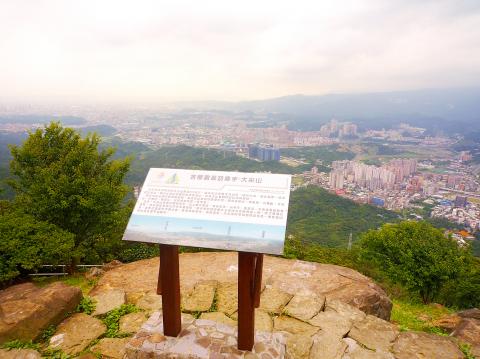
An easier alternative is to take the F911 minibus service that leaves from Sijhih Park (汐止公園; close to the train station) every hour or so and shuttles passengers almost all the way to Tiansiou Temple, near the trailheads to both Sioufong Waterfall and Dajian Mountain. From here it’s just over an hour’s climb via the waterfall to the summit.
Pray for a heavy downpour before climbing Dajian Mountain. The deluge won’t affect the quality of the wide, stepped paths too much, but it will make one of the scenic highlights of the walk, Sioufong Waterfall, worth seeing.
Set in a deep, rocky ravine on the side of the steep ridge above Sijhih, the waterfall makes a fine show as it glides down a steep rock face eroded with countless crinkly serrations that give it a distinctive appearance, but in dry weather it dries up almost completely.
If the waterfall fails to impress, there’s the Dragon Boat Cave (a tall, narrow, crack-like cavern through which the path passes) to enjoy en route. To get to the waterfall, follow the road past Tiansiou Temple, and a few minutes after it, at a sharp bend, take the signposted trail on the right.
From Sioufong Waterfall, a stepped path climbs to the road above, and a few meters further uphill another path leaves the road and heads straight up the steep, darkly wooded upper slopes of Dajian Mountain: a short but steep trudge. At the top, turn left to a wooden ornamental rain shelter to claim your reward: a remarkable, bird’s eye view of Sijhih, laid out along the valley of the Keelung River directly below, looking west towards Taipei in the distance.
More visually appealing is the panorama across to Yangmingshan (陽明山) and Guanyin Mountain (觀音山) ahead, and, to the right, the twin pyramids of Keelung Mountain (基隆山) and Peace Island (和平島), looming out of the East China Sea and presenting an especially sharp and impressive profile from this distant vantage point.
If you walk the entire distance from Sijhih train station, pay your respects on the way at one of Taiwan’s more unique temples. Turn left off Sioufong Road beside a brightly colored temple three hundred meters south of highway 5, and follow this lane as it climbs stiffly to an enormous new temple complex at the top (a 10-minute climb from the junction.)
This is the very handsome temple of Zihhang Tang. Walk up through the fine temple complex to the pagoda at the top. Inside the figure covered in gold leaf and protected by a glass case, is the incorruptible (mummified) body of a former monk, who died in 1943. It’s said to be one of three such incorruptible corpses in Taiwan, but this is the most famous, and an object of veneration for countless Buddhists.
Richard Saunders is a classical pianist and writer who has lived in Taiwan since 1993. He’s the founder of a local hiking group, Taipei Hikers, and is the author of six books about Taiwan, including Taiwan 101 and Taipei Escapes. Visit his Web site at www.taiwanoffthebeatentrack.com.

Nine Taiwanese nervously stand on an observation platform at Tokyo’s Haneda International Airport. It’s 9:20am on March 27, 1968, and they are awaiting the arrival of Liu Wen-ching (柳文卿), who is about to be deported back to Taiwan where he faces possible execution for his independence activities. As he is removed from a minibus, a tenth activist, Dai Tian-chao (戴天昭), jumps out of his hiding place and attacks the immigration officials — the nine other activists in tow — while urging Liu to make a run for it. But he’s pinned to the ground. Amid the commotion, Liu tries to

The slashing of the government’s proposed budget by the two China-aligned parties in the legislature, the Chinese Nationalist Party (KMT) and Taiwan People’s Party (TPP), has apparently resulted in blowback from the US. On the recent junket to US President Donald Trump’s inauguration, KMT legislators reported that they were confronted by US officials and congressmen angered at the cuts to the defense budget. The United Daily News (UDN), the longtime KMT party paper, now KMT-aligned media, responded to US anger by blaming the foreign media. Its regular column, the Cold Eye Collection (冷眼集), attacked the international media last month in

A pig’s head sits atop a shelf, tufts of blonde hair sprouting from its taut scalp. Opposite, its chalky, wrinkled heart glows red in a bubbling vat of liquid, locks of thick dark hair and teeth scattered below. A giant screen shows the pig draped in a hospital gown. Is it dead? A surgeon inserts human teeth implants, then hair implants — beautifying the horrifyingly human-like animal. Chang Chen-shen (張辰申) calls Incarnation Project: Deviation Lovers “a satirical self-criticism, a critique on the fact that throughout our lives we’ve been instilled with ideas and things that don’t belong to us.” Chang

Feb. 10 to Feb. 16 More than three decades after penning the iconic High Green Mountains (高山青), a frail Teng Yu-ping (鄧禹平) finally visited the verdant peaks and blue streams of Alishan described in the lyrics. Often mistaken as an indigenous folk song, it was actually created in 1949 by Chinese filmmakers while shooting a scene for the movie Happenings in Alishan (阿里山風雲) in Taipei’s Beitou District (北投), recounts director Chang Ying (張英) in the 1999 book, Chang Ying’s Contributions to Taiwanese Cinema and Theater (打鑼三響包得行: 張英對台灣影劇的貢獻). The team was meant to return to China after filming, but